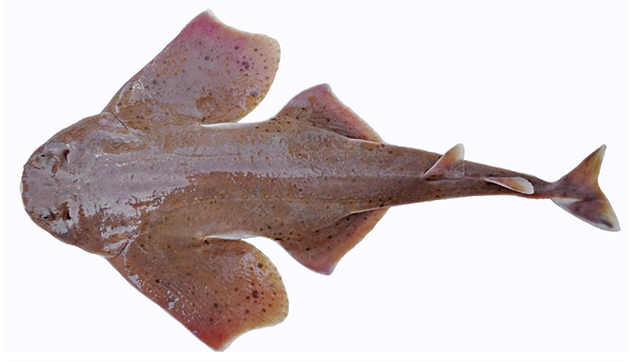|
Dorsal spines (total): -0; Dorsal soft rays (total): -0; Anal spines: -0. Diagnosis: Mid-dorsal line lacking thorns or enlarged, sharp, pointed dermal denticles; eye-spiracle distance larger than 1.5 times eye diameter in specimens larger than 60 cm TL; each nasal flap with 2 rod-like barbels, outer barbel divided; coloration grayish to brownish yellow, male dark-spotted, females with abundant whitish spots (Ref. 110242).
Description: Dorsal surface covered with interspersed denticles of relative roughness, a densely concentrated patch of small curved spines along anterior pectoral-fin margins in mature males, poorly developed in females; ventral surface comparatively smooth, except for narrow bands of denticles along anterior margins of both pectoral and pelvic fins; head rounded, length around 5 times in TL, with a maximum width occurring anterior of gill openings; moderate tubercles interspersed above mouth and eye crests, smooth oval patch above midpoint of mouth in between eyes; eyes almond-shaped, closely set, with an interorbital space 11-13 times in TL; eye-spiracle distance relatively large, 30–43 times in TL; spiracles crescent-shaped with pronounced interior papillae along posterior margin; interorbital space around 1.1 times larger than interspiracle space; center of upper lip arch exposed at midpoint of upper jaw, exposure semi-oval in shape; labial furrows, roughly equal in length, extending from corners of mouth medially, with upper labial furrow partially covered with dermal folds; distinct nasal flaps protruding from dermal folds above mouth, 2 barbels protruding from each flap; inner nasal barbels rod-like, containing little if any fringe; outer nasal barbels rod-like with a small branch protruding ventrally near tip; nostrils large, protruding slightly, and tear-shaped; dermal folds along exterior of head, 1 small lobe present at corners of mouth extending ventrally; mouth length about 0.3 times as long as mouth width; dentition consisting of small, dagger-like teeth, conical without cusplets on a broad base, in 2 orderly longitudinal rows on upper jaw, 3 rows on bottom jaw, no teeth at symphysis, 10 teeth by row in each jaw; pectoral fins large and broadly rounded, originating just behind gills; anterior margin of pectoral fin mostly straight, 0.8–0.9 as long as pectoral length, extending to a lateral apex; margin from lateral apex to posterior-most lobe slightly concave; posterior lobe broadly rounded; pectoral inner margin about 1/2 of pectoral length, convex, and with a small lobe near pectoral base; overall pelvic fin shape somewhat triangular with rounded fin tips; pelvic fins originating anterior to pectoral fin free rear tips; pelvic fin length 0.5-0.8 long as pectoral fin length; pelvic-fin base usually longer than pectoral-fin base, anterior margin 0.5–0.65 times as long as pelvic fin length; posterior margin of pelvic fin straight to posterior free tip approximately 0.7 times fin length; pelvic inner margin straight and short, approximately 0.4 times as long as pectoral fin length; pelvic-fin insertion furrows on ventral side extend in a narrow ellipse to anterior apogee of vent, vent is within ellipse; 1 pelvic-fin tip extends to 1st dorsal origin, the other does not; dorsal fins slightly angular, 2nd dorsal fin slightly smaller than 1st dorsal fin, with denticles covering the entirety of both fins; dorsal-caudal space 1.0–1.4 times longer than interdorsal space; anterior margin of both dorsal fins straight, nearly equidistant; dorsal-fin bases subequal; posterior margins straight, about 0.5–0.7 times as long as anterior margins; inner margin of dorsal fins straight, approximately 0.2–0.5 times as long as anterior margins; caudal peduncle compressed dorso-ventrally with lateral longitudinal ridges, tapering posteriorly; caudal fin lobelike, markedly at dorsal apex, dorsal margin broadly rounded, about 0.7–0.9 times as long as preventral caudalfin margin; subterminal caudal-fin margin approximately 1.4 times longer than caudal upper postventral margin; caudal lower postventral margin slightly convex, approximately 1.5 times longer than caudal upper postventral margin (Ref. 110242).
Coloration: Grayish to brownish yellow; male with dark spots, subequal to smaller than eye diameter; females with abundant whitish spots, smaller than eye diameter (Ref. 110242). |
